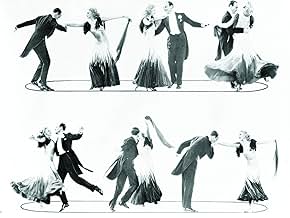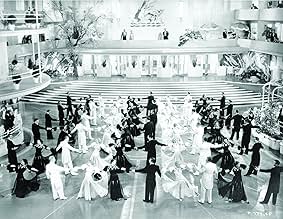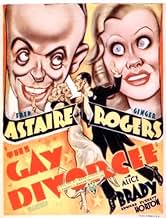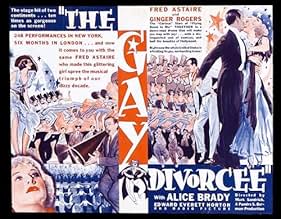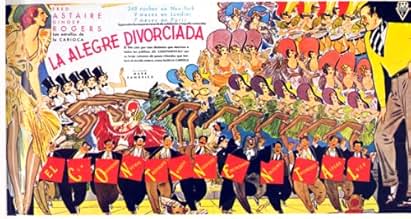IMDb रेटिंग
7.3/10
9.1 हज़ार
आपकी रेटिंग
अपनी भाषा में प्लॉट जोड़ेंA woman thinks a flirting man is the co-respondent her lawyer has hired to expedite her divorce.A woman thinks a flirting man is the co-respondent her lawyer has hired to expedite her divorce.A woman thinks a flirting man is the co-respondent her lawyer has hired to expedite her divorce.
- 1 ऑस्कर जीते
- 4 जीत और कुल 5 नामांकन
Norman Ainsley
- Undetermined Role
- (बिना क्रेडिट के)
Jimmy Aubrey
- Undetermined Role
- (बिना क्रेडिट के)
Finis Barton
- Undetermined Role
- (बिना क्रेडिट के)
Eleanor Bayley
- Dancer
- (बिना क्रेडिट के)
De Don Blunier
- Chorus Girl
- (बिना क्रेडिट के)
Pokey Champion
- Dancer
- (बिना क्रेडिट के)
Jack Chefe
- Night Club Patron
- (बिना क्रेडिट के)
फ़ीचर्ड समीक्षाएं
This was the first RKO film that Fred Astaire and Ginger Rogers did in which they are the central characters. In the first two they play wise cracking supporting roles, and if you don't know what is going on you might say "Hey, why don't Gene Raymond and Delores Del Rio get out of the way and let Fred and Ginger do their stuff?". It was because Fred and Ginger as a team were a bit of a surprise to RKO.
At any rate, like I said, this seems like a warm up for "Top Hat" a year later, but it is still a great film. But the two share a few pieces of the basic formula. Fred and Ginger meet in such a way that annoys Ginger and gets Fred interested, and once Ginger begins to return Fred's affection a complete misunderstanding that Fred knows nothing about causes Ginger to lose all interest in a now confused Fred. Edward Everett Horton plays Fred's loyal but befuddled friend, and Eric Blore, who at first seems like a minor character who is in the film mainly to flummox Horton's character plays a much bigger part in the plot than you would ever imagine. Erik Rhodes plays an Italian who never really has a chance as third vertex in a triangle in which the other two are Fred and Ginger, but he plays that part with great comic style.
A couple of mistakes fixed by "Top Hat" that this one has - First, Fred Astaire is given no solo dance numbers. Second, too much Alice Brady can get annoying. In "Top Hat" her part is taken by Helen Broderick who had a great dry comic wit.
Still, highly recommended.
At any rate, like I said, this seems like a warm up for "Top Hat" a year later, but it is still a great film. But the two share a few pieces of the basic formula. Fred and Ginger meet in such a way that annoys Ginger and gets Fred interested, and once Ginger begins to return Fred's affection a complete misunderstanding that Fred knows nothing about causes Ginger to lose all interest in a now confused Fred. Edward Everett Horton plays Fred's loyal but befuddled friend, and Eric Blore, who at first seems like a minor character who is in the film mainly to flummox Horton's character plays a much bigger part in the plot than you would ever imagine. Erik Rhodes plays an Italian who never really has a chance as third vertex in a triangle in which the other two are Fred and Ginger, but he plays that part with great comic style.
A couple of mistakes fixed by "Top Hat" that this one has - First, Fred Astaire is given no solo dance numbers. Second, too much Alice Brady can get annoying. In "Top Hat" her part is taken by Helen Broderick who had a great dry comic wit.
Still, highly recommended.
After their hit dancing of the "Carioca" in "Flying Down the Rio," RKO gave the teaming of Fred Astaire and Ginger Rogers a star role in "The Gay Divorcée" in 1934.
With few exceptions, the plots of the Fred-Ginger films were excuses to get to the important part - the dancing - but the story lines were always pleasant and the casting good.
"The Gay Divorcée" was based on a Broadway musical (of which the only number retained is "Night and Day") and it appears that a few of its plot devices were adopted in later Astaire-Rogers films as well.
One such plot device is that of mistaken identity. In this movie, Astaire (reprising his Broadway role) is mistaken for a professional correspondent hired to help Rogers get her divorce. Another device is that at first, Ginger is never interested in Fred - that goes here, too.
And there's a stock cast in these films, namely, Edward Everett Horton and Eric Blore (and of course, he's always the butler and always very funny). Horton plays Rogers' attorney whose major problem is Rogers' aunt (Alice Brady).
What can be said about the dancing except that it's glorious? Fred and Ginger dance to "Night and Day" after Astaire sings it to her. For a supposed non-singer, Astaire could really put over a song - his voice is pleasant and he's so musical - no wonder composers wrote songs for him.
Ginger is beautiful and spunky as Mimi, a young woman ducking Fred while she's trying to get a divorce. Betty Grable has a bit that showcases her in the number "Let's K-knock Kneez." There's also "I'm Looking for a Needle in a Haystack" delightfully sung and danced by Fred. Astaire's dancing is fantastic throughout.
It feels as if about half the picture is taken up with the elaborately staged production number, "The Continental." In later films, of course, the dancing would center more around Fred and Ginger, but it's a great part of the movie and certainly solidified these two as a top box office pairing.
For pure enjoyment, there's nothing like watching Astaire & Rogers in these movies.
With few exceptions, the plots of the Fred-Ginger films were excuses to get to the important part - the dancing - but the story lines were always pleasant and the casting good.
"The Gay Divorcée" was based on a Broadway musical (of which the only number retained is "Night and Day") and it appears that a few of its plot devices were adopted in later Astaire-Rogers films as well.
One such plot device is that of mistaken identity. In this movie, Astaire (reprising his Broadway role) is mistaken for a professional correspondent hired to help Rogers get her divorce. Another device is that at first, Ginger is never interested in Fred - that goes here, too.
And there's a stock cast in these films, namely, Edward Everett Horton and Eric Blore (and of course, he's always the butler and always very funny). Horton plays Rogers' attorney whose major problem is Rogers' aunt (Alice Brady).
What can be said about the dancing except that it's glorious? Fred and Ginger dance to "Night and Day" after Astaire sings it to her. For a supposed non-singer, Astaire could really put over a song - his voice is pleasant and he's so musical - no wonder composers wrote songs for him.
Ginger is beautiful and spunky as Mimi, a young woman ducking Fred while she's trying to get a divorce. Betty Grable has a bit that showcases her in the number "Let's K-knock Kneez." There's also "I'm Looking for a Needle in a Haystack" delightfully sung and danced by Fred. Astaire's dancing is fantastic throughout.
It feels as if about half the picture is taken up with the elaborately staged production number, "The Continental." In later films, of course, the dancing would center more around Fred and Ginger, but it's a great part of the movie and certainly solidified these two as a top box office pairing.
For pure enjoyment, there's nothing like watching Astaire & Rogers in these movies.
Following an apparently accidental teaming in 1933's Flying Down to Rio (a fun Dolores Del Rio vehicle), Fred and Ginger got their first starring feature a year later. It was based on J. Hartley Manners' play 'The Gay Divorce'. The Hays Office insisted on shoving an 'e' on the end, for how could a divorce be so trifling as to be gay? Some UK prints still run with the original title. RKO assembled a sparkling ensemble cast of top-flight farceurs, bringing together (in ascending order of sublimity) Eric Blore, Edward Everett Horton and Erik Rhodes ("Are you a union man?"). Mark Sandrich directs the thing with a maximum of fuss and style. Hermes Pan helped Fred choreograph the numbers.
The plot is suitably - and delightfully - trivial. Musical star Guy Holden (Fred) happens upon a girl (Ginger), falls desperately in love with her, then spends the rest of the picture trying to free himself from marvellously silly plot threads and Everett Horton's exquisite quadruple-takes.
Keeping just one song from Cole Porter's original score, the timeless 'Night and Day', and adding only four others, The Gay Divorcée is more a comedy with songs than it is a musical comedy. But what comedy - and what songs! 'Looking For a Needle in a Haystack' is a masterpiece of economy: Fred a whirlwind of frustrated, lovestruck energy as he spins around his hotel room lamenting his missing love in peerless style. "Men don't pine," he memorably concludes, "Women pine. Men ... suffer." Everett Horton's rare excursion into song-and-dance territory is a breath of hysterical, liberating ludicrousness, as he knocks knees with a young Betty Grable. 'Don't Let It Bother You', performed by a chorus of dancing girls (and dolls), then spectacularly reprised by a tapping Astaire, is another treat. 'The Continental', the film's vast production number is peculiarly edited but sporadically fine and offers a fitting climax.
It's exceptional fluff, the sort of heady, heightened escapism that you don't come close to very often. An extravagantly mounted, joyous comedy played to perfection by two stars at their irresistible peak. Unmissable.
The plot is suitably - and delightfully - trivial. Musical star Guy Holden (Fred) happens upon a girl (Ginger), falls desperately in love with her, then spends the rest of the picture trying to free himself from marvellously silly plot threads and Everett Horton's exquisite quadruple-takes.
Keeping just one song from Cole Porter's original score, the timeless 'Night and Day', and adding only four others, The Gay Divorcée is more a comedy with songs than it is a musical comedy. But what comedy - and what songs! 'Looking For a Needle in a Haystack' is a masterpiece of economy: Fred a whirlwind of frustrated, lovestruck energy as he spins around his hotel room lamenting his missing love in peerless style. "Men don't pine," he memorably concludes, "Women pine. Men ... suffer." Everett Horton's rare excursion into song-and-dance territory is a breath of hysterical, liberating ludicrousness, as he knocks knees with a young Betty Grable. 'Don't Let It Bother You', performed by a chorus of dancing girls (and dolls), then spectacularly reprised by a tapping Astaire, is another treat. 'The Continental', the film's vast production number is peculiarly edited but sporadically fine and offers a fitting climax.
It's exceptional fluff, the sort of heady, heightened escapism that you don't come close to very often. An extravagantly mounted, joyous comedy played to perfection by two stars at their irresistible peak. Unmissable.
Guy Holden, the celebrated stage dance star, is touring Europe on vacation. Mimi Glossop is a rich American living in London and is currently in the throes of a divorce. They meet, they dance, they fall in love.
Ginger Rogers was by far the bigger cinema star when RKO Radio teamed her with Fred. She had appeared in 34 films to his 3, and two in the previous year had been smash hits - "Golddiggers" and "42nd Street". This loose borrowing from Cole Porter's Broadway show contains only one of the master's songs, the immortal "Night And Day", and only four other songs in the entire movie - Conrad & Magidson's "Needle In A Haystack" and "The Continental", and Gordon & Revel's "Don't Let It Bother You" and "Let's K-nock K-nees" (featuring an 18-year-old Betty Grable, who had herself featured in no less than eight films in the previous year).
At the depth of the Depression, this sort of film was all the rage - a fantasy of carefree opulence and ease, set in a world of Parisian floorshows, ocean liners and tuxedos. The wit is sharp and the mood flirtatious. What if the film-makers hadn't the first clue about how an English barrister conducts his cases? This is about romance, not professional ethics. What if the terrain of Brighton isn't an igneous intrusion, but in fact a sedimentary accretion? This is about two people's sublime dancing, not geology.
Fred is as always the quintessence of style, a naturally elegant creature, and Ginger is gorgeous. The plot is very well constructed, containing all the misunderstandings associated with musical farce, but developing them with panache. The denouement is both neat and unexpected. There are plenty of girls dancing in the usual geometric patterns, but there is also abundant creativity in the choreography - the playful steps in "The Continental", for example, or Fred's reluctant dance for his supper. Mimi is trying to resist Guy, and has to be drawn into "Night And Day" against her will - an instance of character being expressed through dance. Max Steiner's arrangement of this number is glorious, with its 'tacit', and the swelling fortissimos, and a dainty countermelody in the strings. Ginger sings "The Continental" like an angel, nicely ragging the time.
Inconsequential? No doubt. Frothy? Certainly. A joy to watch? Definitely!
Ginger Rogers was by far the bigger cinema star when RKO Radio teamed her with Fred. She had appeared in 34 films to his 3, and two in the previous year had been smash hits - "Golddiggers" and "42nd Street". This loose borrowing from Cole Porter's Broadway show contains only one of the master's songs, the immortal "Night And Day", and only four other songs in the entire movie - Conrad & Magidson's "Needle In A Haystack" and "The Continental", and Gordon & Revel's "Don't Let It Bother You" and "Let's K-nock K-nees" (featuring an 18-year-old Betty Grable, who had herself featured in no less than eight films in the previous year).
At the depth of the Depression, this sort of film was all the rage - a fantasy of carefree opulence and ease, set in a world of Parisian floorshows, ocean liners and tuxedos. The wit is sharp and the mood flirtatious. What if the film-makers hadn't the first clue about how an English barrister conducts his cases? This is about romance, not professional ethics. What if the terrain of Brighton isn't an igneous intrusion, but in fact a sedimentary accretion? This is about two people's sublime dancing, not geology.
Fred is as always the quintessence of style, a naturally elegant creature, and Ginger is gorgeous. The plot is very well constructed, containing all the misunderstandings associated with musical farce, but developing them with panache. The denouement is both neat and unexpected. There are plenty of girls dancing in the usual geometric patterns, but there is also abundant creativity in the choreography - the playful steps in "The Continental", for example, or Fred's reluctant dance for his supper. Mimi is trying to resist Guy, and has to be drawn into "Night And Day" against her will - an instance of character being expressed through dance. Max Steiner's arrangement of this number is glorious, with its 'tacit', and the swelling fortissimos, and a dainty countermelody in the strings. Ginger sings "The Continental" like an angel, nicely ragging the time.
Inconsequential? No doubt. Frothy? Certainly. A joy to watch? Definitely!
Looking at THE GAY DIVORCEE through the lens of 85 years, I can see flaws with it. The big dance number goes on too long, and the comedy writing isn't sharp enough. Still, this was the first star pairing of Fred Astaire and Ginger Rogers, and it's amazing how much they got right, right off the bat. There's the basic structure of Astaire courting Miss Rogers through a set of dances, while in between there are jokes and pulled faces and Edward Everett Horton doing several hundred double takes per minute as everyone's straight man.
It's based on Astaire's stage success The Gay Divorce. The name change was the result of the Breen office meddling. It's more a variation on the Princess Theater musical comedies of the 1920s, and the camerawork, although seemingly startling and original under the direction of David Abel, is more an outgrowth of German Expressionist camerawork, and bits and bobs from the best of contemporary British musicals. Add in Astaire's insistence on being seen full length while dancing -- which sounds obvious now, although not at the time -- and the formula required only a bit of refinement to produce a series of masterpieces.
You may notice Betty Grable at the bottom of the title card. She's the platinum blonde who makes love to Horton in the "Let's Knock Knees" number. She had been kicking around Hollywood since 1929, sometimes with a credit, sometimes, like her previous movie, without. She would never go uncredited again.
It's based on Astaire's stage success The Gay Divorce. The name change was the result of the Breen office meddling. It's more a variation on the Princess Theater musical comedies of the 1920s, and the camerawork, although seemingly startling and original under the direction of David Abel, is more an outgrowth of German Expressionist camerawork, and bits and bobs from the best of contemporary British musicals. Add in Astaire's insistence on being seen full length while dancing -- which sounds obvious now, although not at the time -- and the formula required only a bit of refinement to produce a series of masterpieces.
You may notice Betty Grable at the bottom of the title card. She's the platinum blonde who makes love to Horton in the "Let's Knock Knees" number. She had been kicking around Hollywood since 1929, sometimes with a credit, sometimes, like her previous movie, without. She would never go uncredited again.
क्या आपको पता है
- ट्रिवियाThe musical number "The Continental" lasts 17 1/2 minutes, the longest number ever in a musical until Gene Kelly's 18 1/2-minute ballet at the end of An American in Paris (1951) 17 years later. It is also the longest musical number in all of Fred Astaire and Ginger Rogers' films together.
- गूफ़During the car chase, Guy makes a quick turn on a dirt road, and a sound effect of squealing tires is heard. Tires do not make a squealing noise on dirt.
- भाव
Tonetti: [unable to remember his passphrase "Chance is a fool's name for fate," Tonettie repeatedly muffs it] Chance is the foolish name for fate. / Give me a name for chance and I am a fool. / Fate is a foolish thing to take chances with. / I am a fate to take foolish chances with. / Chances are that fate is foolish. / Fate is the foolish thing. Take a chance.
- इसके अलावा अन्य वर्जनIn the version of the movie released in Brazil in the 1930s, the Brazilian actor Raul Roulien sang in the musical number "The Continental".
- कनेक्शनEdited into Joan of Paris (1942)
- साउंडट्रैकDon't Let It Bother You
(1934)
Music and Lyrics by Mack Gordon and Harry Revel
Dance performed by Fred Astaire
टॉप पसंद
रेटिंग देने के लिए साइन-इन करें और वैयक्तिकृत सुझावों के लिए वॉचलिस्ट करें
- How long is The Gay Divorcee?Alexa द्वारा संचालित
विवरण
- रिलीज़ की तारीख़
- कंट्री ऑफ़ ओरिजिन
- आधिकारिक साइट
- भाषाएं
- इस रूप में भी जाना जाता है
- La alegre divorciada
- फ़िल्माने की जगहें
- उत्पादन कंपनी
- IMDbPro पर और कंपनी क्रेडिट देखें
बॉक्स ऑफ़िस
- बजट
- $5,20,000(अनुमानित)
- दुनिया भर में सकल
- $6,879
- चलने की अवधि1 घंटा 47 मिनट
- रंग
- पक्ष अनुपात
- 1.37 : 1
इस पेज में योगदान दें
किसी बदलाव का सुझाव दें या अनुपलब्ध कॉन्टेंट जोड़ें




